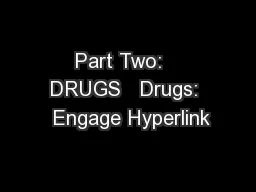

httplearngeneticsutaheducontentaddictiondrugsabusehtml Drugs are either Agonists Mimic Reuptake inhibitors Antagonist s Blocks Reuptake inhibitors Drugs terms ID: 741974
Download Presentation The PPT/PDF document "Part Two: DRUGS Drugs: Engage Hyper..." is the property of its rightful owner. Permission is granted to download and print the materials on this web site for personal, non-commercial use only, and to display it on your personal computer provided you do not modify the materials and that you retain all copyright notices contained in the materials. By downloading content from our website, you accept the terms of this agreement.
Slide1
Part Two: DRUGS
Drugs: Engage Hyperlink
:
http://learn.genetics.utah.edu/content/addiction/drugs/abuse.htmlSlide2
Drugs are either….
Agonists: Mimic
Reuptake inhibitorsAntagonist
s
:
Blocks Reuptake inhibitorsSlide3
Drugs
terms:
Psychological Dependence:
develops when the person has an intense desire to achieve the drugged state in spite of adverse effects.
Tolerance:
decreasing response to a drug
Physiological dependence or addiction
develops when changes in brain chemistry from taking the drug necessitate taking the drug again to prevent withdrawal symptoms.
Withdrawal:
stop taking the drug the body reacts with intense craving for the drug.Slide4
Psychoactive Drug:
are chemicals that can pass through the blood-brain barrier into the brain to alter perception, thinking, behavior, and mood.They are classified into their main effects:Stimulant:
Substance that
increases
activity in body and nervous
systemDepressant:
Substance that
decreases
activity in body and nervous system
Hallucinogen:
Substance that alters or distorts sensory perceptionsNarcotics: or analgesics (pain reducers) which work by depressing the CNS. Opiates, codeine, heroin, opium, methadone.
Drugs
http://www.learner.org/vod/vod_window.html?pid=782Slide5
Psychoactive Drug:
Substance capable of altering behavior Examples include tobacco, alcohol, cannabis, amphetamines, ecstasy, cocaine, and heroine
Drugs
http://www.learner.org/vod/vod_window.html?pid=782
http://wps.aw.com/bc_goodenough_boh_3/104/26721/6840688.cw/content/index.html
Visit the following to see what psychoactive drugs do in your brain:Slide6
Stimulant
sSpeed up
body processes.More powerful ones (like cocaine) give people feelings of invincibility.The most popular stimulants are cocaine, amphetamines such as methamphetamine, Ritalin, ephedrine, ecstasy, crack. Slide7
MethSlide8
Causes
hand tremors, sweating, talkativeness, tinnitus, suppresses fatigue or sleepiness, increases alertnessCaffeinism: Physiological dependence on caffeineWithdrawal: Insomnia, irritability, loss of appetite, chills, racing heart, elevated body temperature
Caffeine
StimulantsSlide9
Natural stimulant found mainly in tobacco
May cause stomach pain, vomiting, diarrhea, confusion, tremorsHighly AddictiveResponsible for 97% of lung cancer deaths in men, 74% in women
NicotineSlide10
W
hat is in a cigarette?Slide11
Depressants
Slows down body processes.AlcoholAnxiolytics (barbiturates and tranquilizers)Slide12
Alcohol
More than 86 billion dollars are spent annually on alcoholic beverages.Alcohol is involved in
60% of ALL crimes.Alcohol is involved in over 70% of sexually related crimes.
Is it worth the cost?
DepressantsSlide13
Involved in up to
60%
of all crimes.Slide14
Dawn Farm Education Series Oct 25, 2007
14Fetal Alcohol Syndrome
teratogens
drugs cross the placental barrierSlide15
Opiates
Has depressive and hallucinogenic
qualities.Agonist for endorphins. Derived from poppy plant.
Depressants
BOMBSlide16
Alter moods, distort perceptions, and evoke sensory images in the absence of sensory input
.Include, LSD, PCP, Marijuana, PeyoteLSD and the Brain
Hallucinogens (psychedelics)Slide17
http://www.5min.com/Video/The-Dangers-of-Smoking-Spice-433300995
Dangers of SpiceSlide18
Though the name may sound harmless, bath salts are a dangerous synthetic stimulant that carry the risk of easy overdose, hallucinations and even death
. Bath Salts
A synthetic, stimulant powder product that contains amphetamine-like chemicals, including
mephedrone
, which may have a high risk for overdoseSlide19
http://www.youtube.com/watch?v=ymiF-okrdMg&feature=related
Don't Drink and Drive Slide20
Detoxification
: Withdrawal of the person from alcohol; occurs in a medical setting and is tightly controlled; often necessary before long-term treatment beginsAlcoholics Anonymous (AA): Worldwide self-help organization composed of recovering alcoholics; emphasizes admitting powerlessness over alcohol usage and wanting to recover.
Treatment for Alcohol Abuse and DependenceSlide21
I have meet many of you with parents or family members that have problems with alcohol and sometimes you feel like there is no one out there to understand. This is not true. Al Anon is an organization dedicated to the family members of alcoholics and I recommend you visit the following website to learn more about one in your area.
http://www.al-anon.alateen.org/Personal note:Slide22
In small quantities, alcohol can be mistaken for a stimulant because it:
A. Inhibits control of emotionB. stimulates the sympathetic nervous systemC. Speeds up respiration and heartbeat
D. Induces sleepE. Affects the cerebellumSlide23
A: After drinking small amounts of alcohol, people are often lively and seem uninhibited. This results from inhibition of the part of the frontal lobes that usually keep emotions in check.Slide24
Of the following, which pair of psychoactive drugs shares the most similar effects on the brain?
A. Alcohol-marijuanaB. Caffeine-morphineC. Nicotine-heroine
D. Amphetamines-cocaineE. Barbiturates-LSDSlide25
D
. Amphetamines and cocaine are both classified as stimulants